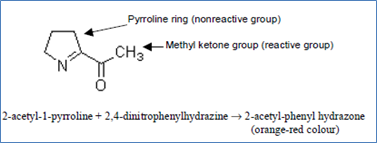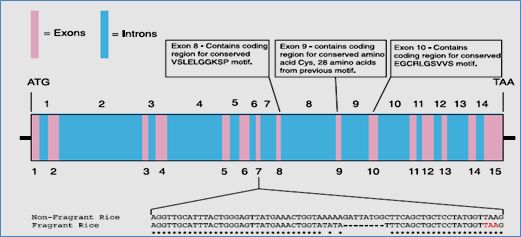Authors: Jyoti Prakash Sahoo
Ph.D Research Scholar, Department of Agricultural Biotechnology, College of Agriculture, OUAT, Bhubaneswar - 751003
*Correspondence mail id : jyotiprakashsahoo2010@gmail.com
Aromatic Rice
Rice is the most important staple food for a large part of the world’s human population. Rice varieties with aroma quality, known as aromatic or fragrant rice, have earned a reputation and wide popularity. Aromatic rice constitutes a small but special group of rice which are considered best in quality. Aromatic rice is of different types: Short grain, medium grain and long grain aromatic rice. Majority of the Indian indigenous aromatic rice are small and medium-grained.
Aromatic compound in Rice
Aroma in rice is a result of numerous volatile and semi volatile compounds. There are more than 250 volatile and non-volatile compounds reported in both aromatic and non-aromatic rice varieties. 2-acetyl-1-pyrroline (2AP) is the major volatile compound responsible for fragarance or popcorn-like aroma in several of the Asian aromatic rice varieties. It was firstly identified by R. Buttery and his co-workers (1982).
2-acetyl-1-pyrroline (2AP)- a potent flavour molecule in rice
It is a five-membered N-heterocyclic ring compound. Its IUPAC name is 2-acetyl-3,4-dihydro- 2H-pyrrole and 1-(3,4-dihydro-2H-pyrrol-5-yl)-ethanone. Its chemical formula is C6H9NO. It is having molar mass 111.14 g·mol −1.
Extraction techniques for 2AP from rice
- Liquid–solid extraction (LSE): Using organic solvents (dichloromethane)
- Simultaneous steam distillation/ solvent extraction (SDE) : volatile components were extracted by simultaneous steam distillation/ solvent extraction (SDE) apparatus
- Solvent Assisted Flavor Evaporation (SAFE): Isolation of volatiles under vacuum from solvent extracts
- Direct thermal analysis technique: Volatiles can be thermally extracted directly and together with the carrier gas flow through a solid matrix sample.
- Headspace sampling techniques: A technique particularly suitable for separating and determining volatile compounds present in solid or liquid samples.

Figure 1. Structure of 2AP
2, 4-dinitrophenyl hydrazine has been successfully used for the detection of 2AP. The structure of 2AP shows that it has a non-reactive pyrroline ring and reactive methyl ketone group. The reactive methyl ketone group reacts with 2,4-dinitrophenyl hydrazine to give an orange-red coloured compound, 2- acetyl-phenyl hydrazone.
Quantification of 2AP in rice
Static Headspace Gas Chromatography (SHS-GC) (Sriseadka et al., 2006) is employed for quantitative analysis of 2AP in grains of fragrant rice. This method provides satisfactory recovery and sensitivity of 2AP by the utilization of both flame ionization detector (FID) and nitrogen-phosphorus detector (NPD). Additionally, Static Headspace Gas Chromatography- nitrogen-phosphorus detector (SHS-GC-NPD) demonstrated the possibility of both higher selectivity and sensitivity of the analysis of 2AP to be as low as 5 ng. Recently, a stable isotope dilution assay (SIDA), involving headspace solid-phase microextraction (HS-SPME) combined with gas chromatography–positive chemical ionization-ion trap-tandem mass spectrometry (GC–PCI-ITMS–MS) was developed for 2AP quantification (Maraval et al., 2010). Limits of detection (LOD) and quantification (LOQ) for 2AP were 0.1 and 0.4 ng.g−1 of rice, respectively.

Figure 2. Structure of the aroma / fragrance gene (fgr) (Bradbury et al., 2005)
Genetic and molecular basis of aroma
Primary fragrance character/trait is controlled by a single recessive gene located on chromosome 8 of the rice genome. This gene is a mutated nonfunctional Badh2 gene which codes for the synthesis of betaine aldehyde 1, 3 dehydrogenase (BADH2). An eight base pair deletion in Badh2 gene in aromatic rice leads to the generation of a premature stop codon at position 753, which shortens the full-length peptide to 252 amino acids and resulted abrogation of the function of the enzyme BADH2. The synthesis of truncated non-functional BADH2 enzyme leads in the accumulation of Δ1-pyrroline which reacts non-enzymatically with methylglyoxal to form 2-acetyl-1-pyrroline. But in non-aromatic rice the functional Badh2 gene codes for a 503 amino acid mature protein which consumes the substrate (Δ1-pyrroline) in non-fragrant varieties resulting non-synthesis of 2-acetyl-1-pyrroline.
2AP biosynthesis pathway in rice
Bradbury et al. (2008) suggested that there are two possibilities with regard to betaine aldehyde dehydrogenase (BADH2) enzyme activity in the biosynthesis pathway of 2AP. Proline was transformed metabolically into γ-aminobutyraldehyde (GABald) via oxidation of putrescine. GABald is the substrate of betaine aldehyde dehydrogenase (BADH2). If BADH2 is functional (in case of non- aromatic rice) GABald is oxidized to γ-aminobutyric acid (GABA). On the other hand, if BADH2 is non-functional (in case of aromatic rice) the GABald can spontaneously cyclise into 1-pyrroline which is then acetylated to generate 2AP.

Figure 3. Biosynthesis and regulation of 2-acetyl-1-pyrroline (2AP in rice)
References:
Yoshihashi, T., Huong, N. T. T., & Inatomi, H. (2002). Precursors of 2-acetyl-1-pyrroline, a potent flavor compound of an aromatic rice variety. Journal of agricultural and food chemistry ,50 (7), 2001-2004.
About Author / Additional Info: